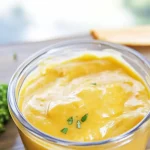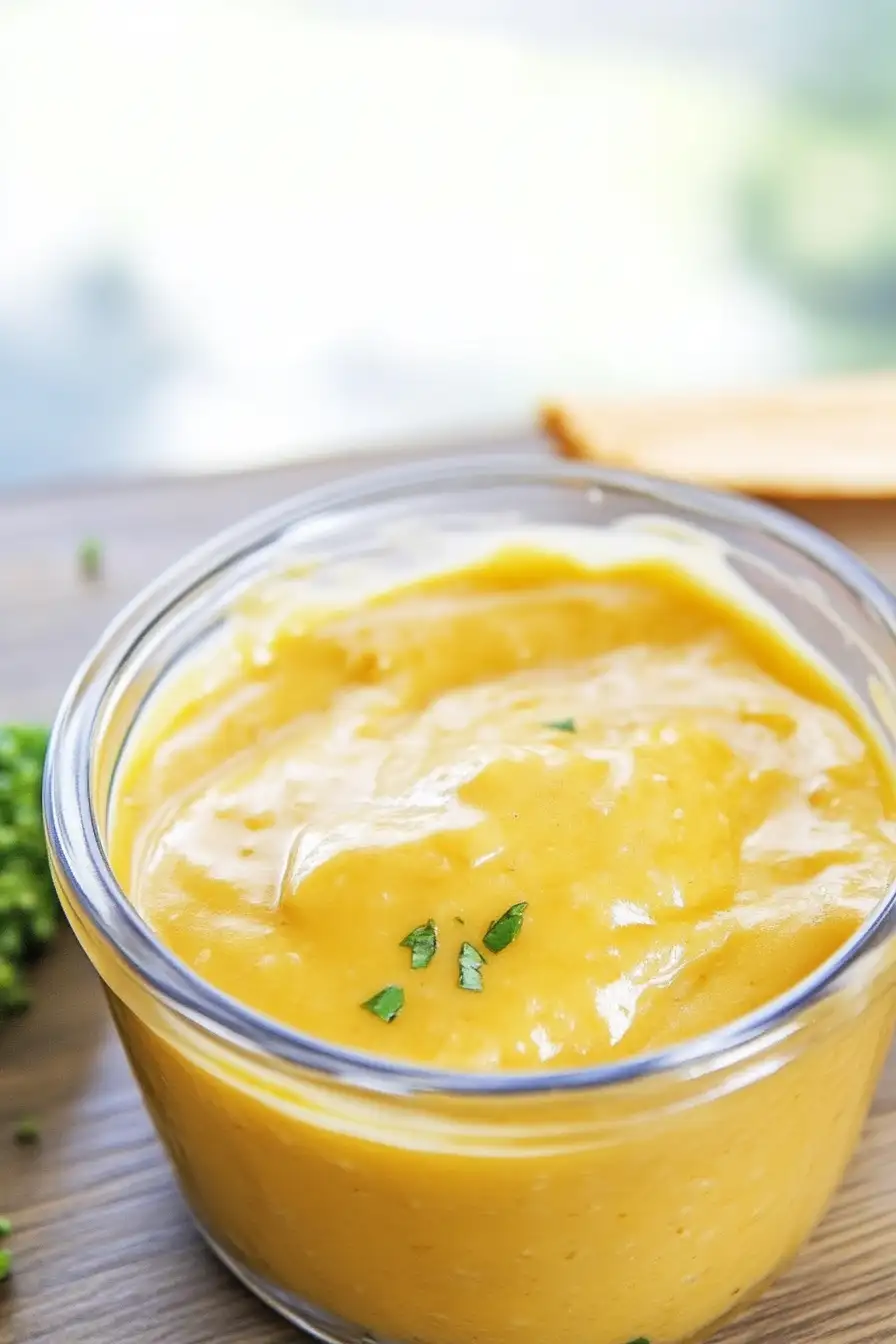If you follow a low-carb lifestyle, Keto Cheese Sauce can be your quick answer to “what can I drizzle on… everything?” I make it in under ten minutes, and the silky texture never lets me down. You will only need a handful of pantry items, yet the result feels rich enough for a celebration dinner.
Keep reading—I walk you through each step, share smart add-ins, and cover storage, reheating, and common troubleshooting questions.
Table of Contents
What Is Keto Cheese Sauce
Keto Cheese Sauce is a creamy blend of butter, almond flour, heavy cream, sharp cheddar, and light seasoning. The almond flour stands in for the usual wheat-based roux, giving the sauce body without pushing up the carb count.
Melt those ingredients together at gentle heat and you end up with a sauce that coats vegetables, proteins, or low-carb noodles with ease.
Ingredient
- Butter, unsalted — 2 tablespoons
- Super-fine almond flour — 2 tablespoons
- Heavy cream — ¾ cup
- Extra-sharp cheddar, shredded — 1½ cups
- Dijon mustard — ½ teaspoon
- Garlic powder — ¼ teaspoon
Equipment
- Small heavy-bottom saucepan
- Silicone or wooden spoon
- Measuring cups and spoons
- Grater (if shredding cheese yourself)
How To Make Keto Cheese Sauce
- Warm the pan: Place the saucepan over low to medium-low heat and add the butter. Let it melt slowly; you do not want the butter to brown at this stage.
- Build a keto roux: Sprinkle in the almond flour while whisking or stirring with the spoon. The mixture will form a loose paste. Cook this paste for roughly one minute to remove any raw nut taste. The key is gentle heat—no rushing here.
- Stream in the cream: Still stirring, pour in the heavy cream in a thin stream. Keep the sauce moving until the paste dissolves and the liquid thickens slightly. Small bubbles around the edges signal you are ready for cheese.
- Fold in the cheddar: Lower the heat to the minimum setting. Add the shredded cheese in three small handfuls, letting each addition melt before adding the next. Stir patiently; direct high heat can break the sauce.
- Season: Finish with Dijon mustard and garlic powder. Stir until smooth, then taste. Extra salt is rarely needed because sharp cheddar carries a salty edge on its own.
- Serve: Remove the pan from heat. The sauce will thicken more as it cools, which makes it ideal for dipping or pouring.
Variations
- Spicy kick: Stir in a pinch of smoked paprika or crushed red pepper near the end of cooking.
- Tex-Mex twist: Swap half the cheddar for pepper jack and add a teaspoon of chopped pickled jalapeño.
- Italian spin: Replace cheddar with shredded mozzarella and a tablespoon of grated Parmesan, then add a sprinkle of dried oregano.
- Beer cheese style (low-carb beer only): Reduce the cream by two tablespoons and replace that volume with a keto-approved light beer. Warm the beer before adding to prevent sudden temperature shock.
Serving Ideas
Cheese sauce drapes beautifully over steamed broccoli, roasted cauliflower, or grilled chicken. I spoon it over bunless burgers, ripple it through cooked spaghetti squash, and use it as a dip for low-carb pretzel bites.
When we host game night, a small fondue pot keeps the sauce warm for hours and guests dunk celery sticks or sausage links without stopping the fun to reheat.
Notes
- The cheese matters. Extra-sharp cheddar gives deeper flavor and melts smoothly if shredded fresh. Bagged cheese often contains anti-clumping starch that can thicken the sauce too far.
- Low heat preserves texture. High heat can split the sauce into oil and solids. If that happens, whisk in a tablespoon of cold cream off the heat to bring it back together.
- Mustard’s role is small yet important. It brightens the richness without shouting its own name.
- If the sauce feels thick after standing, a splash of warm cream revives it.
Storage & Reheat
Cool leftovers to room temperature, then transfer to an airtight container. Refrigerate up to four days.
To reheat, place the sauce in a small saucepan over low heat with a tablespoon of cream. Stir until loose and glossy again. A microwave works too—short 20-second bursts, stirring each time, prevent hot spots.
Freezing is possible but can create a slightly grainy finish after thawing; I only freeze when absolutely needed and plan to whisk vigorously during reheating.
Common Questions
Q: Can I replace almond flour with coconut flour?
A: Coconut flour absorbs far more liquid, turning the sauce pasty. Stick with almond flour for best consistency.
Q: My sauce looks oily. What happened?
A: The cheese probably melted at heat that was too high, causing fats to separate. Remove from heat, whisk in cold cream a teaspoon at a time, and the emulsion usually returns.
Q: Is pre-shredded cheese okay?
A: You can use it in a pinch, but expect a slightly thicker sauce due to starches added to bagged cheese.
Q: How can I make the sauce thinner for pouring over steak?
A: Increase the cream by two tablespoons or whisk in chicken broth at the end until you reach the texture you like.
Q: Does this work with dairy-free cheese?
A: Many plant-based shreds refuse to melt smoothly. If you need dairy-free, pick a vegan cheese known for melting and add it gradually while whisking to keep the sauce unified.

Keto Cheese Sauce
- Total Time: 15 minutes
- Yield: About 1 ½ cups (6 servings)
- Diet: Gluten Free
Ingredients
- Butter, unsalted — 2 tablespoons
- Super-fine almond flour — 2 tablespoons
- Heavy cream — ¾ cup
- Extra-sharp cheddar, shredded — 1½ cups
- Dijon mustard — ½ teaspoon
- Garlic powder — ¼ teaspoon
Instructions
- Warm the pan: Place the saucepan over low to medium-low heat and add the butter. Let it melt slowly; you do not want the butter to brown at this stage.
- Build a keto roux: Sprinkle in the almond flour while whisking or stirring with the spoon. The mixture will form a loose paste. Cook this paste for roughly one minute to remove any raw nut taste. The key is gentle heat—no rushing here.
- Stream in the cream: Still stirring, pour in the heavy cream in a thin stream. Keep the sauce moving until the paste dissolves and the liquid thickens slightly. Small bubbles around the edges signal you are ready for cheese.
- Fold in the cheddar: Lower the heat to the minimum setting. Add the shredded cheese in three small handfuls, letting each addition melt before adding the next. Stir patiently; direct high heat can break the sauce.
- Season: Finish with Dijon mustard and garlic powder. Stir until smooth, then taste. Extra salt is rarely needed because sharp cheddar carries a salty edge on its own.
- Serve: Remove the pan from heat. The sauce will thicken more as it cools, which makes it ideal for dipping or pouring.
Notes
- The cheese matters. Extra-sharp cheddar gives deeper flavor and melts smoothly if shredded fresh. Bagged cheese often contains anti-clumping starch that can thicken the sauce too far.
- Low heat preserves texture. High heat can split the sauce into oil and solids. If that happens, whisk in a tablespoon of cold cream off the heat to bring it back together.
- Mustard’s role is small yet important. It brightens the richness without shouting its own name.
- If the sauce feels thick after standing, a splash of warm cream revives it.
- Prep Time: 5 minutes
- Cook Time: 10 minutes
- Category: Sauce
- Method: Stovetop
- Cuisine: American
Nutrition
- Serving Size: 1 serving
- Calories: 180 kcal
- Sugar: 1 g
- Sodium: 310 mg
- Fat: 16 g
- Saturated Fat: 10 g
- Unsaturated Fat: 5 g
- Trans Fat: 0 g
- Carbohydrates: 2 g
- Fiber: 0 g
- Protein: 7 g
- Cholesterol: 45 mg

